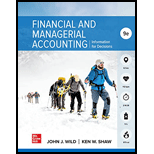
a.
An accounting equation is formed by three main elements, namely, asset account, liability account and equity account. The formation is done as: Assets = Liabilities + Equity.
Every business transaction can be identified and analyzed through this accounting equation for the purpose of further analyzing the effects of each such transaction on the asset, liability and equity.
To Record: The
b.
An accounting equation is formed by three main elements, namely, asset account, liability account and equity account. The formation is done as: Assets = Liabilities + Equity.
Every business transaction can be identified and analyzed through this accounting equation for the purpose of further analyzing the effects of each such transaction on the asset, liability and equity.
To
c.
Accounting Equation:
An accounting equation is formed by three main elements, namely, asset account, liability account and equity account. The formation is done as: Assets = Liabilities + Equity.
Every business transaction can be identified and analyzed through this accounting equation for the purpose of further analyzing the effects of each such transaction on the asset, liability and equity.
To Prepare: The
Want to see the full answer?
Check out a sample textbook solution
Chapter 2 Solutions
FINANCIAL+MANAG.ACCT.(LOOSELEAF)-TEXT
- What is the company's plantwide overhead rate?arrow_forwardKindly help me with this general accounting questions not use chart gpt please fast given solutionarrow_forwardSolve step by step: A company has the following information for the year:Net Income: $200,000Dividends Paid: $50,000Beginning Retained Earnings: $100,000What is the ending retained earnings?arrow_forward
- Could you explain the steps for solving this financial accounting question accurately?arrow_forwardNo use AI , A company purchased equipment for $50,000. It expects the equipment to have a useful life of 5 years and no salvage value. Using the straight-line method of depreciation, what is the annual depreciation expense?arrow_forwardHow much is the standard cost per direct labor hour for variable overhead ?arrow_forward
- ??arrow_forwardi want to this Financial Accounting question answerarrow_forwardsolve step by step : A company purchased equipment for $50,000. It expects the equipment to have a useful life of 5 years and no salvage value. Using the straight-line method of depreciation, what is the annual depreciation expense?arrow_forward
- I need help with this general accounting question using the proper accounting approach.arrow_forwardA company has the following information for the year:Net Income: $200,000Dividends Paid: $50,000Beginning Retained Earnings: $100,000What is the ending retained earnings?arrow_forwardI am searching for the correct answer to this general accounting problem with proper accounting rules.arrow_forward
- Principles of Accounting Volume 2AccountingISBN:9781947172609Author:OpenStaxPublisher:OpenStax College
 Accounting Information SystemsAccountingISBN:9781337619202Author:Hall, James A.Publisher:Cengage Learning,
Accounting Information SystemsAccountingISBN:9781337619202Author:Hall, James A.Publisher:Cengage Learning,

